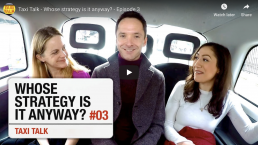Whose strategy is it anyway?
provider: youtube
url: https://www.youtube.com/watch?v=ItrAevb-zU4&feature=youtu.be
src in org: https://www.youtube.com/embed/ItrAevb-zU4?feature=oembed&width=840&height=1000&discover=1
src in mod: https://www.youtube.com/embed/ItrAevb-zU4?width=840&height=1000&discover=1
src gen org: https://www.youtube.com/embed/ItrAevb-zU4
In this third episode our three contributors Kath, Richard and Haifa grapple with a question that repeats more frequently than a garlic vol-au-vent: Whose strategy is it? (strategy that is)
Let’s build a strategy!
All too often it feels like the strategy for any brand is recreated a million times over, because everyone who comes into contact with it wants to add their two pence, and show they understand the problem better than everyone else. This means the strategy ends up being a jumble of disconnected thoughts – a noisy mess that achieves little more than to bombard the target audience with meaningless stuff. Instead, the strategy should be something to build and grow, not to periodically scrap and start again. That means it’s hard work – it needs to be more considered from the outset, and more applicable to the endpoint.
Strategy doesn’t stop once the direction is set, we still need to get there. The commonly held belief that delivering against a strategy is somehow the poor cousin of developing one is frustratingly out-dated. What use is a strategy if it isn’t delivered? Delivering against a strategy is often harder than developing one, but so many people are so quick to say ‘that’s not my job’? It’s not about where one job stops and another job starts, it’s about creating seamless understanding and ownership.
For this reason, and because it makes damn good sense, developing the strategy should be much more inclusive, not left to the select few who have permission to be smart. No one has all the answers, but a lot of people have some of them. Then it needs to be focused down, and we need to be strict with it. Once it’s done, everyone needs to believe in it and make it happen. It’s a collaborative process, not a competition.
Of course, it needs to be clever in thought, genuinely well informed with insight, and big enough to cover the whole marketing mix. But it also needs to be meaningful, bringing with it a promise to change things rather than just communicate things. That way the strategy won’t be a piece of academic theory that never sees the light of day, it will readily translate into practice.
In the end, this allows the strategy to achieve what it set out to do in the first place – have a positive impact in the real world. Isn’t that what we’re doing this for?
Respecting the sum and its parts
You wouldn’t walk into an operating theatre, suggest to the surgeon that they might want to think about making that cut 4mm to the right, and offer to close the patient. Equally you wouldn’t bowl onto a building site laying bricks, ‘just because they look good there’ and all because you’ve seen and been in lots of houses. Human beings are generally good at respecting others’ expertise, so why is this so often not the case with graphic design? Do people not see this specialist area as an expertise?
Creativity benefits from like minds, collaborating and challenging one another in a constructive way. I certainly work better in this environment and believe that work is stronger and more robust as a consequence. No one, however, wants to be told how to do their job and disappointingly this happens more than I’d care to remember in the agency world. This tension between different parts of the internal team is usually due to poor communication (crazy right!) and can be incredibly damaging. If people aren’t working together towards a common goal or aren’t able to recognise and respect each other’s expertise, then the team isn’t working and the outputs will suffer.
This is why I believe it is so important to have the right team involved from the start, ensuring that we are all on the same page. Too often I have seen critical people missing from the initial stages of a project, citing that there is not enough budget to warrant so many people’s time. What undoubtably results is that more and more meetings are needed to unpick and solve problems further down the line, with more and more senior members included to try and get the work back on track. Ironically this results in spending more time and money than if all parties were invested in to begin with! Plus now with the added problem of having way too many cooks and too little time to complete the work with any aplomb.
All too often the root of the problem stems from not having agreed on, or written, a good enough brief. Now hang on a minute, before you groan with boredom and roll your eyes, just hear me out. If we as a united team; agency and client together, have defined and understood the problem, worked out a direction and plan to solve it together, then a lot of the friction later on can be avoided. By working together, embracing the restrictions and pressure points rather than fighting against them, we can ensure the output retains its strength and relevance and fulfils the initial need.
We have all spent time learning our respective craft, not because we wanted to be handed a list of instructions, but because we thrive on seeing good ideas come to life. We get a buzz out of using our expertise to create positive change and make a difference to people’s lives, and we all invest our precious time to achieve the outcomes we believe in. Quite simply, we need to have respect for, and see the value in, the expertise people bring to the table, and that only through collaboration and communication can truly great things happen. Once we believe this, we can finally build strong, bespoke, challenging, ‘fit for purpose’ teams that deliver truly exceptional work.


